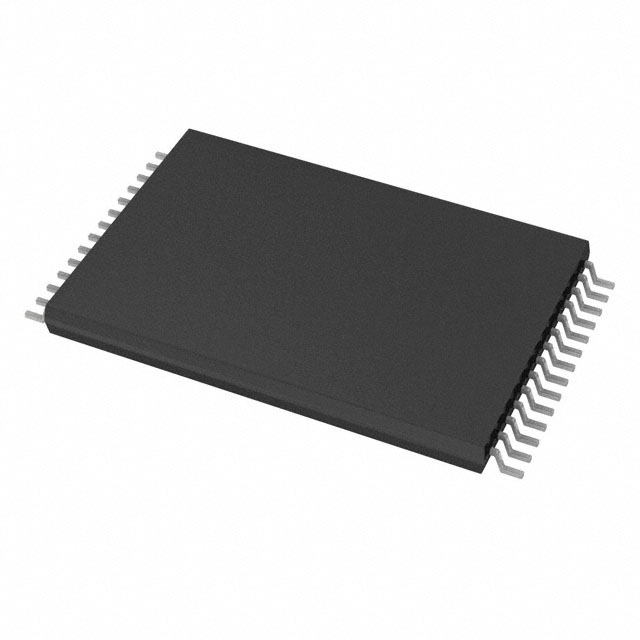Xem thông số kỹ thuật để biết chi tiết sản phẩm.

AT28HC256-12TC
Product Overview
Category: Integrated Circuit (IC)
Use: The AT28HC256-12TC is a high-speed, low-power Electrically Erasable Programmable Read-Only Memory (EEPROM) IC. It is designed to store and retrieve digital information in various electronic systems.
Characteristics: - High-speed operation - Low power consumption - Non-volatile memory - Large storage capacity - Reliable data retention - Easy to interface with microcontrollers
Package: The AT28HC256-12TC is available in a 32-pin Thin Small Outline Package (TSOP). This package provides a compact form factor and allows for easy integration into electronic devices.
Essence: The essence of the AT28HC256-12TC lies in its ability to provide non-volatile memory storage with high-speed operation and low power consumption. It offers a reliable solution for storing critical data in electronic systems.
Packaging/Quantity: The AT28HC256-12TC is typically sold in reels or tubes, with each reel or tube containing a specific quantity of ICs. The exact packaging and quantity may vary depending on the supplier.
Specifications
- Memory Size: 256 kilobits (32 kilobytes)
- Organization: 32K x 8 bits
- Supply Voltage: 2.7V - 5.5V
- Access Time: 120 ns
- Operating Temperature Range: -40°C to +85°C
- Data Retention: 10 years
- Write Endurance: 100,000 cycles
Pin Configuration
The AT28HC256-12TC has a total of 32 pins. The pin configuration is as follows:
- A16
- A15
- A14
- A13
- A12
- A7
- A6
- A5
- A4
- A3
- A2
- A1
- A0
- VCC
- OE#
- CE#
- WE#
- I/O0
- I/O1
- I/O2
- I/O3
- I/O4
- I/O5
- I/O6
- I/O7
- NC
- GND
- NC
- NC
- NC
- NC
- NC
Functional Features
- High-speed operation allows for fast data access and retrieval.
- Low power consumption makes it suitable for battery-powered devices.
- Non-volatile memory ensures that data is retained even when power is disconnected.
- Easy interfacing with microcontrollers simplifies integration into electronic systems.
Advantages and Disadvantages
Advantages: - High-speed operation enables quick data transfer. - Low power consumption prolongs battery life in portable devices. - Non-volatile memory ensures data retention without the need for constant power supply. - Easy interfacing simplifies integration into existing systems.
Disadvantages: - Limited storage capacity compared to other memory technologies. - Relatively higher cost per bit compared to some alternative memory solutions. - Limited write endurance may require careful management of write operations.
Working Principles
The AT28HC256-12TC utilizes EEPROM technology to store and retrieve digital information. It employs a combination of electrically controlled gates and floating gate transistors to store data in non-volatile memory cells. The stored data can be accessed and modified using specific control signals provided by the microcontroller or system.
Detailed Application Field Plans
The AT28HC256-12TC finds applications in various electronic systems, including but not limited to: - Embedded systems - Automotive electronics - Industrial control systems - Consumer electronics - Medical devices
Its high-speed operation, low power consumption, and non-volatile memory characteristics make it suitable for applications that require reliable data storage and retrieval.
Detailed and Complete Alternative Models
- AT28C256-15PU: Similar to the AT28HC256-12TC, this model offers a 256 kilobit EEPROM with an access time of 150 ns.
- AT28BV256-20TU: This alternative model provides a 256 kilobit EEPROM with an access time of 200 ns and operates at a lower voltage range of 2.7V - 3.6V.
- AT28HC256E-90TI: This model offers a 256 kilobit EEPROM with an access time of 90 ns and operates at a wider temperature range of -40°C to +125°C.
These alternative models provide options with different specifications to cater to specific application requirements.
In conclusion, the AT28HC256-12TC is a high-speed, low-power EEPROM IC that offers
Liệt kê 10 câu hỏi và câu trả lời thường gặp liên quan đến ứng dụng AT28HC256-12TC trong giải pháp kỹ thuật
Sure! Here are 10 common questions and answers related to the application of AT28HC256-12TC in technical solutions:
Q: What is the AT28HC256-12TC? A: The AT28HC256-12TC is a high-speed, low-power CMOS 256K (32K x 8) EEPROM memory chip.
Q: What are some typical applications for the AT28HC256-12TC? A: The AT28HC256-12TC is commonly used in embedded systems, microcontrollers, automotive electronics, industrial control systems, and other applications that require non-volatile memory storage.
Q: What is the operating voltage range of the AT28HC256-12TC? A: The AT28HC256-12TC operates within a voltage range of 4.5V to 5.5V.
Q: What is the maximum clock frequency supported by the AT28HC256-12TC? A: The AT28HC256-12TC supports a maximum clock frequency of 12 MHz.
Q: How much data can be stored in the AT28HC256-12TC? A: The AT28HC256-12TC has a total capacity of 256 kilobits or 32 kilobytes.
Q: Does the AT28HC256-12TC support byte-level read and write operations? A: Yes, the AT28HC256-12TC supports both byte-level read and write operations.
Q: Can the AT28HC256-12TC be reprogrammed multiple times? A: Yes, the AT28HC256-12TC is electrically erasable and can be reprogrammed multiple times.
Q: What is the access time of the AT28HC256-12TC? A: The AT28HC256-12TC has an access time of 120 ns, meaning it takes 120 nanoseconds to read or write data.
Q: Does the AT28HC256-12TC have any built-in security features? A: No, the AT28HC256-12TC does not have any built-in security features.
Q: What is the temperature range in which the AT28HC256-12TC can operate? A: The AT28HC256-12TC can operate within a temperature range of -40°C to +85°C.
Please note that these answers are based on general information about the AT28HC256-12TC and may vary depending on specific datasheet specifications.

